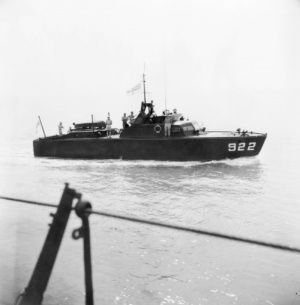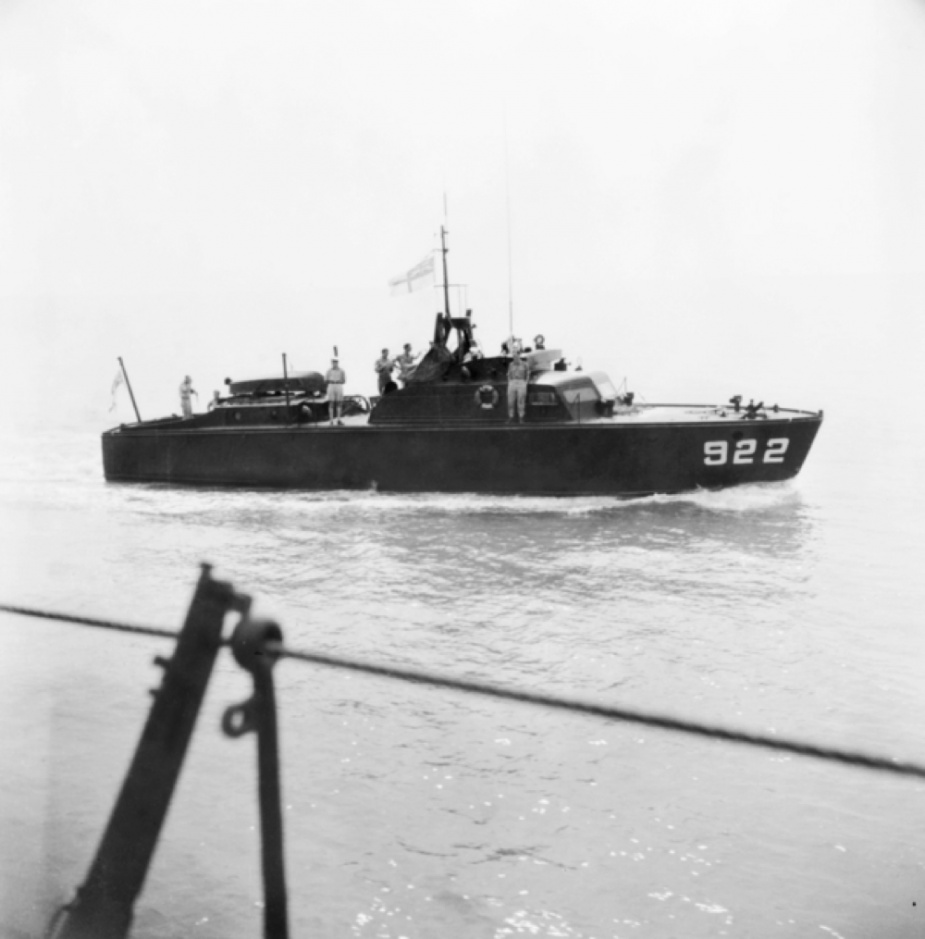HMAS Air Clan
| Class |
Air/Sea Search and Rescue Vessel |
|---|---|
| Type |
Air-Sea Rescue Launch |
| Pennant |
ASR922 |
| Builder |
Harbor Boat Building Co, USA |
| Commissioned |
11 December 1944 |
| Decommissioned |
30 September 1946 |
| Fate |
Transferred to the Royal Australian Air Force in 1949 |
| Dimensions & Displacement | |
| Displacement | 24 tons |
| Length | 63 feet (19.2 metres) |
| Beam | 15 feet (4.57 metres) |
| Draught | 3 feet 4 inches (1.01 metres) |
| Performance | |
| Speed | Up to 28 knots |
| Complement | |
| Crew | 7-8 including 2 RAAF telegraphists |
| Propulsion | |
| Machinery | Twin Hall-Scott petrol engines |
| Horsepower | 1200 bhp |
| Armament | |
| Guns | 2 x twin Lewis guns |
HMAS Air Clan was one of 21 air/sea rescue (ASR) vessels originally built in the USA and Canada between 1943 and 1945, and transferred to the RAN under the Lend-Lease Agreement. These vessels were originally designed as anti-submarine craft but their high speed and manoeuvrability made them ideal as search and rescue vessels. In this role, their hulls were painted black and their upper decks and superstructure painted bright yellow. One vessel, HMAS Air Sprite, was built locally in 1960 to an almost identical design.
Air Clan was commissioned on 11 December 1944 in Sydney under the command of Lieutenant Osmonde May, RANVR, and officially listed as a tender to HMAS Rushcutter, and later to HMAS Madang. She remained alongside in Rushcutters Bay immediately after commissioning awaiting the installation of additional radio equipment. Following trials and inspection of underwater fittings, she finally put to sea on 27 February 1945 to support exercises at the RAN Torpedo Range in Broken Bay.
She conducted search and rescue duties for the Royal Navy Fleet Air Arm in Jervis Bay in March before proceeding north to New Guinea at the end of the month. She arrived in Port Moresby in company with her sister ships, HMA Ships Air Host and Air Rest, on 10 April before continuing on to Mios Weondi, spending part of the passage under tow from HMAS Bathurst (I), where she conducted an anti-aircraft shoot in conjunction with Bathurst. She sailed for Morotai in early May, again spending part of the passage under tow this time from HMAS Bundaberg (I), to take up ASR duties in support of the RAAF.
She proceeded on to Borneo in June where she struck a floating log necessitating the replacement of her starboard screw and shaft. While alongside she experienced an air raid by a lone Japanese aircraft. The aircraft was shot down after dropping just one bomb with no damage or casualties incurred.
She conducted no less than five search and rescue operations in July and August with RAAF personnel being recovered off Labuan Island, Jesselton (Kota Kinabalu) and Mukah. She also acted as a mobile headquarters for Service Reconnaissance Department parties conducting reconnaissance operations in the area.
That September, Air Clan formed part of the Kuching Relief Force, which also included the corvette HMAS Kapunda, the motor torpedo boat tender USS Willoughby, and six USN patrol torpedo (PT) boats, which was to accept the surrender of Japanese forces in the Kuching area and secure the release of some 2000 prisoners of war and internees. The Commanding Officer of the Japanese forces in the area, Major General Hiyou Yamamura, had been due to embark in Kapunda at Pending at 14:00 on 11 September to sign the surrender document but, after failing to arrive, Air Clan was dispatched to retrieve him. She returned with the General’s Chief of Staff who informed the commander of the Kuching Relief Force, Brigadier (later Sir) Thomas Eastick, CMG, DSO, ED, that Major General Yamamura was indisposed. Air Clan was ordered to return ashore with the Chief of Staff and bring off Major General Yamamura forthwith. A guard from Air Clan escorted the Chief of Staff back ashore and the General was found with his aide de camp in the wireless transmitting station at Pending Wharf. All of the Japanese officers were searched and the General’s aide was found to be carrying a loaded revolver. Major General Yamamura was embarked in Air Clan at 14:30 and the surrender proceedings began aboard Kapunda at 14:37.
Air Clan returned the General ashore at the conclusion of the ceremony and then proceeded up the Sarawak River into Kuching itself with the commanding officers of the occupying force units embarked. She secured alongside the Steamship Wharf thus being the first RAN vessel to enter Kuching. Air Clan spent most of the remainder of the month in the Kuching area ferrying supplies and Allied personnel, including liberated prisoners of war and internees, into and out of Kuching. On 29 September she embarked two officers from Kuching Force Headquarters and proceeded to Lundu and Sematan to inform the local inhabitants of the liberation of Borneo and to determine the food situation, the state of the civil administration and the presence of any Japanese forces.
She returned to Labuan in early October to provide ASR support for aircraft movements between Labuan and Kudat, and on 24 October acted as pilot for four Royal Navy Landing Ships - Tank arriving at Jesselton.
Air Clan remained alongside at Labuan for most of November to conduct maintenance, however, she required base assistance to complete the large amount of work and she departed for Sydney, under tow by HMAS Latrobe as far as Townsville, on 28 November. She completed her slow passage south when she arrived in Sydney on Christmas Eve. After undergoing a refit she proceeded northwards to Darwin under tow of HMAS Condamine and later HMAS Barwon in tandem with HMAS Air Master. The voyage proved a difficult one as the tow parted several times in heavy weather and the two ASRs also collided several times. However, Air Master, Air Clan and Barwon all arrived safely in Darwin on 17 April 1946. She visited Port Moresby again briefly before decommissioning at Brisbane on 30 September 1946. She was transferred to the RAAF in 1949.





